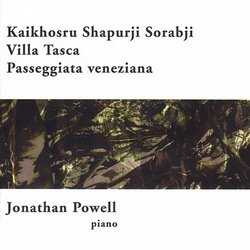| All Artists: Sorabji, Powell Title: Passeggiata Veneziana / Villa Tasca Members Wishing: 1 Total Copies: 0 Label: Altarus Release Date: 9/24/2002 Genre: Classical Styles: Chamber Music, Historical Periods, Classical (c.1770-1830) Number of Discs: 1 SwapaCD Credits: 1 UPC: 076958706721 |
Search - Sorabji, Powell :: Passeggiata Veneziana / Villa Tasca
CD Details |
CD ReviewsMarvelously powerfully spun music scarecrow | Chicago, Illinois United States | 12/03/2003 (5 out of 5 stars) "The vast music edifice and oceanic durational frames within the piano solo works of Sorabji can be distinguishable into expressive realms, places, imaginative and real, images, icons, forms, shapes, and places and means of discourse as sequential musical patternings works merely for ornamental excursion as "Gulistan" and here certain parts and moments of the "Passeggiata veneziana"(herafter Pv).The Italianate expressive strain in Sorabji is prevalent and pervasive in that his mother was Sicilian. Her family name - Malvitrano di Sanctis- is a common within the inhabitants of Palermo. The other strain or discourse refers to moments(the linear perceptions) within the history of music. Perhaps the 1830s with Robert Schumann's "Carnaval" a reaction to the staid statis of what was becoming Romaticism, the frozen structural dynamics of the Beethoven aesthetic. We find then the works of Listz in contradistinction, an aesthetic more extroverted,more self-indulgent, caustic, not afraid of failure, and conceptually free. The materials generated are from the programmatic as we have known in particular the"travelling" ones the"Soirees italiennes" or the "Venezia e Napoli" the appendix to the second, Italian book of his "Annees de pelerinage". This patrilinear quest then finds Ferruccio Busoni next perhaps the most vibrant influence on Sorabji.Busoni's excursions extend to his "Passeggiata arlecchinsca" or the "Rondo arlecchinesco" But without this perspective of Listz, Busoni's oeuvre and Sorabji for that matter means little.The "Pv" is constructed much like a free divertissment suite, it renders itself admirably as a written almost free improvisation something Listz had proclaimed and practiced with his operatic transcriptions, yet Sorabji lends a far deeper expressive dimension to this genre.We hardly sense the "tyranny" of time in Sorabji. The music is free. It does get "stuck" with repetitive moments, as arpeggiated-like octaves and thirds, a Listian device.But we are carried along with Offenbach's well-known melody, the "Barcarola" from the "Tales of Hoffmann". Yes it is subtle here, like a nuance a "fragrance" and Sorabji was well aware of the amount of cognitive/perceptive "space" for the listener a popular melody would hold a magnetic listening power.The work unfolds something like a variations yet seemless you never sense where one movement ends and another begins, simply textural, timbral changes, even the rollicking "Tarantella" is a breath of air here.On a more serious plateau we have the "Villa Tasca" subtitled "mezzogiorno siciliano evocazione nostalgico" and is prefaced by Mallarme's phrase "le fer silence du midi".It is about the imaginative time we sense and feel from real time. There are many associative images here all hovering in places the "Sicilian Muleteer's Song, We find this in the final moments of this lamost one-hour work. Sorabji's music is always compelling in the sheer beuaty of the piano timbre, the upper register filigrees, quite dense yet you.one always senses a direction, landing in places, very much like the anxieties associated with the dialectic of travel, fusing the real with the imaginative. There was a felt "collectivity" that Sorabji drew from his experiences in Sicily and his thoughts, and renders the exquisite timbres here like "spun silk" with multifarious arabesques and numinous ornamentations as Ronald Stevensen ( a close friend and scholar of Sorabji's music)The connection to the East is a felt one in that Sicily had an Arab population and it is this history that seems to hover within the work. Concretely musically it remains to be heard. The work was completed in 1979, one of the last.Jonathan Powell brings a well passioned yet visionary beauty to both works, impeccably disciplined but allowing the works to be what they are."
|

